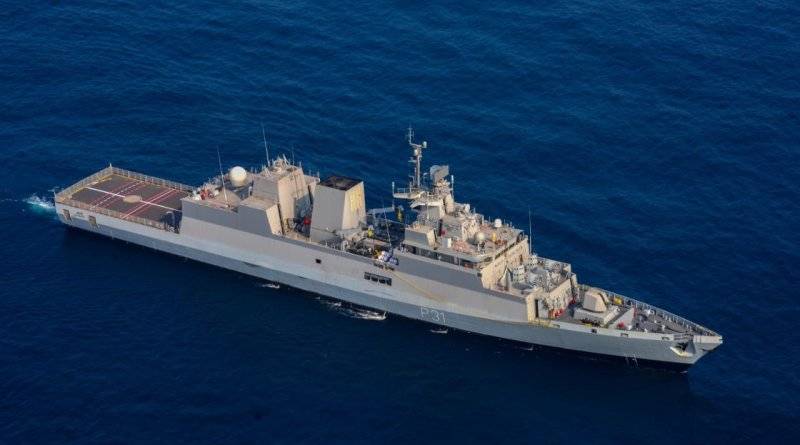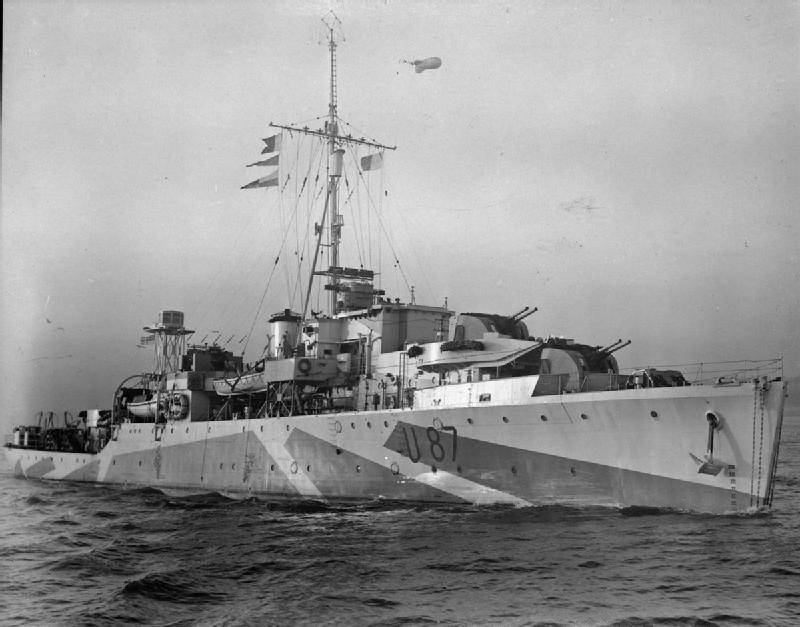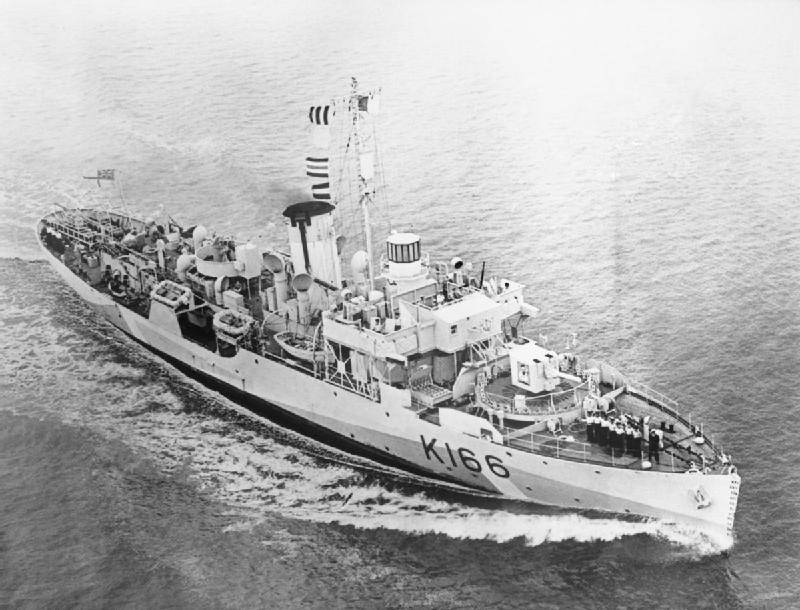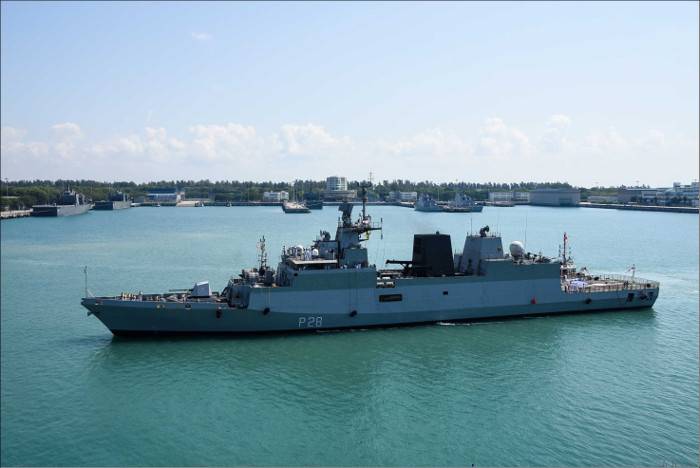Ocean corvette as an option to study

In the Navy of different countries there are many concepts that are suitable for some countries and not suitable for others. For example, a fully nuclear submarine fleet does not fit Russia for both economic and geographical reasons. Non-nuclear submarines are not needed by the United States for anything, except for their potential transfer to Taiwan. Small countries generally do not need aircraft carriers.
One such concept is the "ocean corvette." AT stories there were examples of such ships, and now some states in the ranks have something similar to them ships.
Does Russia need this type of warship? No, right now. Right now, such ships are not needed in Russia. However, in pursuing an active foreign policy, which Russia is clearly striving for, the Navy may face a host of relatively simple combat missions in regions of the world very far from our shores, and on the other hand, there may be a need for a sharp increase in the combat strength of the Navy, and, importantly, without a corresponding increase in funding. The latter, generally speaking, can be considered guaranteed.
And if such conditions really develop, then, perhaps, the concept will be sharply in demand. And to use it, it is worth exploring it, along with all the pros and cons. And for this it is worth paying attention to some examples and analogies.
Flower class
The risk of war with Germany and, as a result, the risk of a submarine war on the British Atlantic communications put the latter in dire need: they had to very quickly, in an incredibly short time, build or take somewhere many escort ships capable of at least somehow protecting convoys from submarines. If old surface ships, which the British assigned to convoys at first, could fight against surface raiders, then something else was needed against submarines.
Shortly before the war, the British reclassified all “sloops” into corvettes - colonial ships of small displacement, in which speed was sacrificed for range. But it was clear that they were not enough.

They weren’t enough, as a result, at the first stage of the war, the British received (in exchange for a network of military bases!) 50 old dilapidated destroyers from the U.S. Navy, which also belonged to the First World War, plus the sloops and other available light ships. As one English officer put it, "the worst ships in the world." This was obviously not enough, and the armed convoys, for example, fishing trawlers, massively embarked on the protection of the convoys.
This was obviously a temporary solution; it worked poorly. We needed massive, simple and cheap escort ships that could "close" the tasks of PLO convoys at the crossing, at least somehow able to carry out the ocean transition, and if necessary, fight in the open ocean with submarines. They became corvettes of the "Flower" type.

The British worried about these ships too late, an order for the first batch of new corvettes was issued just a few months before the start of World War II. The first "Flowers" began to enter the Royal Navy in August-September 1940, the remaining allies and dominions began to receive them later. In total, 294 corvettes of various modifications were built.
The "Flowers" were warships in their purest form. These were small thousand-ton ships with terrifying living conditions. Their weapon it was many times worse than that of the sloops: 1 102-mm caliber cannon for shooting at submarines in the above-water position, two 12,7 mm caliber machine guns for shooting at air and surface targets, two Lewis machine guns chambered for 0.303 inches (7,7, 2 mm). But for the destruction of submarines, the corvettes had two Mk.40 and XNUMX depth bombs - a special anti-submarine mission affected.
Later, a slightly enlarged version was designed and built with a slightly better habitability, an anti-aircraft machine gun and a Hedgehog bomb.
The hull design was based on a whaling ship, as a result of such ships many shipyards could build.
For the sake of economy, the ships had only one valolinia, and also in order to save and facilitate the crew recruitment, instead of the usual turbines, the ships were equipped with a 2750 hp steam engine, just like the whaling prototype. Two boilers worked on crude oil. The speed of the corvette barely reached 16,5 knots.
But then he had a radar and a sonar.
These corvettes have become a vital defense tool for convoys. The number of attacks they thwarted is huge. The number of submarines that they sunk during the war is not so great - 29 units. But their main task was to ensure the safety of convoy ships and they carried it out.
The "Flowers" were an example of an ocean corvette: a small ship with limited functionality, simple and cheap, with low performance characteristics, but massive and really capable of performing combat missions in the ocean. These corvettes played a critical role in the Battle of the Atlantic and for the British are one of the symbols of victory over Germany. The corvette was built in two versions, each of which was then gradually modernized.
We list some common points in the concept that Flower was built by:
- maximum simplicity and mass ("more ships for less money");
- saving on everything except what is needed to carry out a combat mission (PLO, moreover, not so much by defeating German submarines as by preventing the attack of a convoy);
- the presence on board of everything necessary to perform the main task - PLO;
- performance characteristics, reduced to the minimum acceptable level in order to save and reduce production costs;
- the ability to act in the open ocean. The latter is especially worth mentioning: at small sizes, this ship literally threw it like a sliver on the waves, but usually it remained stable and could use deep bombs, which was required of it.
After the war, the class of ocean-going corvettes disappeared: there was no need to solve the tasks that these ships solved during the Second World War. Small ships remained in fleets masses of countries, but basically now their specialization was now different.
Contemporaneity
The increase in the size of warships was unchanged throughout the post-war years, this was due to the explosive increase in the required volumes for electronic weapons, generating capacities, cable routes, missile weapons, hangars for helicopters, sonar equipment. These corvettes did not pass, today they are more than some destroyers of the Second World War. So, the corvettes of the project 20380 of the Russian Navy have a total displacement of more than 2400 tons. However, even against the background of modern large corvettes, there are patterns that stand out in this part.
One of these types of ships is the Indian Navy Corvette type "Camort". This ship, created as an anti-submarine, is distinguished by the fact that it is oversized for its composition of weapons. It is too large for the set of weapons that it carries. For example, in comparison with the domestic project 20380, “Kamorta” has neither a missile system for attacking surface targets, nor a corresponding radar system, the gun of an Indian ship is more likely to perform air defense tasks (76 mm) than that of an attack ship in a Russian ship (100 mm ) At the same time, the Indian ship is 2 meters wider than the Russian one at the waterline, only 70 centimeters wider (its width is equal to that of the American frigates Oliver Hazard Perry), but the total displacement is approximately 870 tons higher.

Unlike the 20380, the Kamorta pays great attention to the comfort of the crew, which facilitates its long stay at sea. The range of the Camorta is 4000 nautical miles, and the autonomy is 15 days, which corresponds to our ship.
“Kamorta” cannot be called an ocean corvette, although this ship is a little closer to it because of its habitability.
But he has something in common with the "Flowers", namely, "slaughtered" under the task of performance characteristics. This ship has a full set of anti-submarine weapons and a Barak anti-aircraft missile system good for a corvette. But the shock capabilities of this ship are zero. At the same time, he is quite capable of moving in the ocean and, apparently, using torpedo weapons with sufficiently serious unrest. The result is savings.
Slow speed hints that it may have been coined as a convoy. The escort ship does not need speed, but it is quite possible to save on a low-speed power plant.
The Indians obviously did not try to make a multi-purpose ship, but did not spare the volumes for a specialized anti-submarine corvette, providing it with good seaworthiness. For reference: if it weren’t for the helicopter, then all of the Kamorta’s weapons would fit into 1100-1300 tons of displacement. And there are more than 3000 tons full.
Another example of an overgrown corvette is the criticized Russian ship of project 20386. Those who wish to familiarize themselves with what this project represents can read the articles “Worse than a crime. Construction of corvettes of the project 20386 - a mistake","Corvette 20386. Continuation of the scam" and "Is alteration of project 20386 planned". In addition to these technical and tactical issues, another project was identified for the project: the 6RP gearbox, which was considered as the basis for the power plant of this ship, is created on the basis of the P055 gearbox, "around" which the power plant of remarkable frigates of project 22350 is built. The problem is that Zvezda LLC -reducer ”, which manufactures both gears, simply can’t master the two series, and you have to choose: either leave 22350 in production, or INSTEAD IT to start building 20386 in some version, even if it’s big, in the original one.
Common sense dictates to choose frigates that are much more powerful and valuable for the fleet.
Among other things, the ship lit up in a political scandal: figures from shipbuilding seem to have tried to convince the president that his re-laying is the laying of a new ship. The result was not good, details in the article “Shipbuilding riddle of 2019, or When four equals five».
The project is clearly harmful for the country. But one aspect worth noting is worth noting: this ship, with all its global flaws, has better seaworthiness than previous corvettes. It has a common “ideological” moment with Camorta: in its original version, it is oversized for the alleged composition of the weapon. Due to this and due to the fact that specific hulls are used for the hull, the ship is distinguished by better seaworthiness than project 20380 corvettes, and less loss of speed on rough seas.
This does not make the idea of its construction true, but the question of creating just a simple and cheap corvette with a weapon composition similar to project 20385 and simplified electronic weapons for cheapness and mass, but in an enlarged case and with an increased range, it would be worth considering. And that's why.
In the Northern Fleet, weather conditions are very severe even in summer, and three-point excitement is almost the norm, excitement also happens very often.
In such circumstances, a corvette larger than 20380/5 could be very useful. In addition, mainly in long-distance campaigns and military services, our ships go from the Northern Fleet. And taking into account the fact that the underwater threat does not decrease, the presence of a good anti-submarine in the composition of the warships with minimal restrictions on the use of weapons on waves would not be amiss.
Nevertheless, it is worth repeating: while this is not particularly necessary, Russia in its current status will do without ocean corvettes.
But everything can change. In which case can such ships be useful?
Corvette as an expansion tool
As you know, for a long time the supply of the Syrian army was carried out using the landing ships of the Navy, their shuttle flights received the widely known name "Syrian Express". Less well known is that at first the fleet had no relation to these transportations: they were dealt with by the ATT, the Department of Transport Support of the Ministry of Defense. We had to switch to using ships under the naval flag after the chartered vessels with ammunition and military equipment for the Syrians began to be stopped, detained in ports of third countries and inspected. The matter clearly went to the blockade, and then the Navy entered the business. The role of the fleet in saving Syria can be found in the article “Russian Navy against the United States and the West. Example from recent operations».
But an attempt to repeat something similar in Libya would have been impossible. Even if Russia really needed it. A “Libyan express” from Turkey is working right now in Libya, which actively supports the Turkish fleet, and on the Turkish territory itself there are Turkish forces ready for immediate use in the Libyan war aviation. What if Russia would need for some reason (we will not discuss it now) to secure control over the entire Libyan territory? And if, at the same time, President Mursi or someone similar to him, the protege of the Muslim Brotherhood (banned in Russia) and the great friend of Recep Erdogan would still be in power in Egypt?
Russia would have to retreat just as it is now. To retreat because she would not have any strength to parallel to the Turkish "Libyan express" put her "Libyan express" in there, to provide him with military protection as in the form of naval strike forces that could prevent an open attack of ships and ships with military cargo, and convoy forces capable of protecting these ships and vessels at transitions from allegedly random or not random, but anonymous attacks of someone's submarines, drones, unmarked Cold War fighters who flew in from nowhere, some ragamuffins on motorboats, who by chance had high-class professional training, and similar threats.
Libya is a different story. But at present, Russia is actively working on economic penetration into Africa. While our total turnover with the “black continent” is small, it does not even reach a billion dollars, but it is growing, and the presence of Russian companies in Africa is growing, and the question of what will one day have to protect these investments will arise sooner or later. And then everything that we were late for with Libya might suddenly be needed.
Including some kind of "African express." And if there are countries in the world that will not be interested in the reliable and uninterrupted operation of this express train, and if these countries have the Navy, then an overgrown corvette with a long range, capable of using weapons at great excitement, will be very useful.
There are other considerations.
At present, the domestic fleet is still largely composed of ships of the Soviet period. But they are not eternal. At the same time, after the massive decommissioning of the BOD, it will be extremely difficult to quickly reimburse these ships. The PLO of naval strike groups operating in the far sea zone will have to be carried out either by the ships performing the strike missions themselves, or by corvettes of project 20380, of which only 10 units were laid down for the entire Navy (and another pair 20385). At the same time, corvettes have worse seaworthiness compared to large ships and a lower speed. It turns out that frigates 22350, which, it seems, will be our main ships of the far sea zone, will have to carry out strike missions, engage in anti-submarine defense, and repel air strikes. It looks a little realistic.
At the same time, as already mentioned, we are faced with difficult times from the point of view of financing: money will be allocated, but in such quantities that the traditional way will not build a full-fledged fleet.
It was then to help large surface ships that a simple, cheap and massive anti-submarine appeared, which, nevertheless, could maneuver at the same speed with them and use weapons on pitching, if necessary. In some cases, this will prove to be quite useful. The concept of "more fleet for less money" ocean corvette is quite consistent. The threats that were listed above, such a corvette may well withstand.
Conclusions
One way to quickly and inexpensively increase the number of fleets that can operate in the far sea zone is to build ships, a subclass of which can be defined as an "ocean corvette".
Such a ship is a corvette, the hull of which has been enlarged to the size that allows it to conduct military operations in the DMZ, far from the coastline, with the unrest inherent in such areas. He also needs a range that is comparable to the range of large surface ships, and comparable speed with them. Moreover, in order to save money and speed up construction, the expansion of the composition of weapons and weapons on board the corvette to values corresponding to the dimensions of the ship is not performed. It is possible and acceptable to build such ships as specialized ones, for example, anti-submarine ones.
Such ships will be able to operate in the composition of warship units in the DMZ, but at a price they will be close to normal “corvettes”.
Separately, it is worth mentioning that in the conditions of the Northern Theater, these ships will be more suitable than traditional corvettes or smaller than corvettes warships.
Such a solution has not only advantages, but also disadvantages. For example, the narrow specialization of ocean corvettes is unlikely to allow them to be used for anything other than its main purpose.
Being more expensive than “normal” corvettes, they will have the same combat capabilities with them, with the exception of restrictions on the use of weapons on waves and range.
Being cheaper than full-fledged warships, they will also require the preparation of a comparable number of personnel to form crews, and from the point of view of naval command control, this process will be complicated as much as a full-fledged warship.
For these reasons, the ocean corvette, on the one hand, cannot be considered a fully demanded solution, which should immediately begin to be implemented. However, such a decision in the near future may still be in demand and necessary, which means that it is necessary to work out the concept of such a ship and comprehensively study the possibilities that it can provide and the circumstances upon which it should be with us.
- Alexander Timokhin
- GRSE, Indian Navy, Imperial War museums collection (Royal Navy photographer),
Information